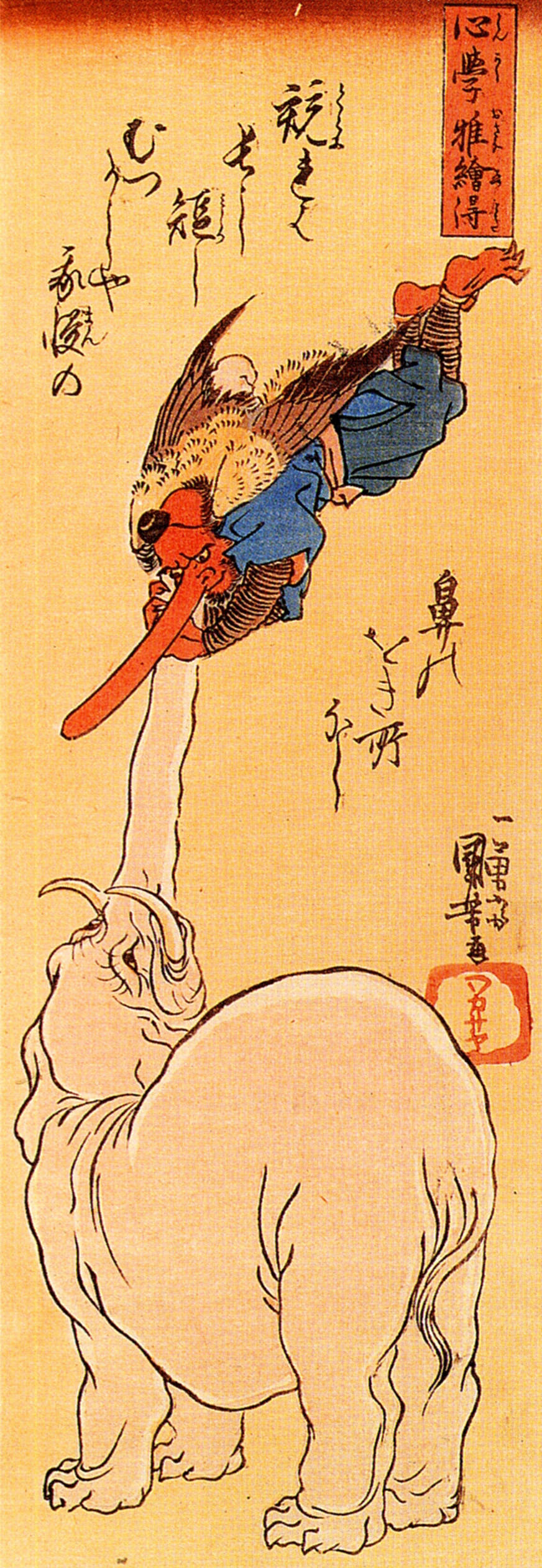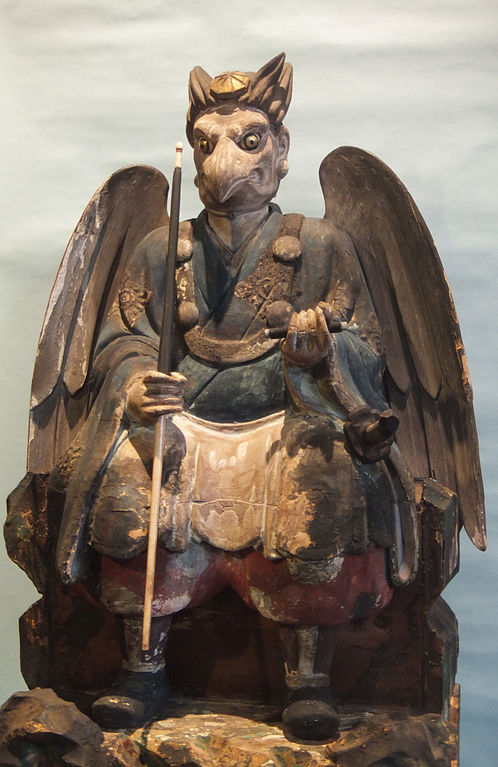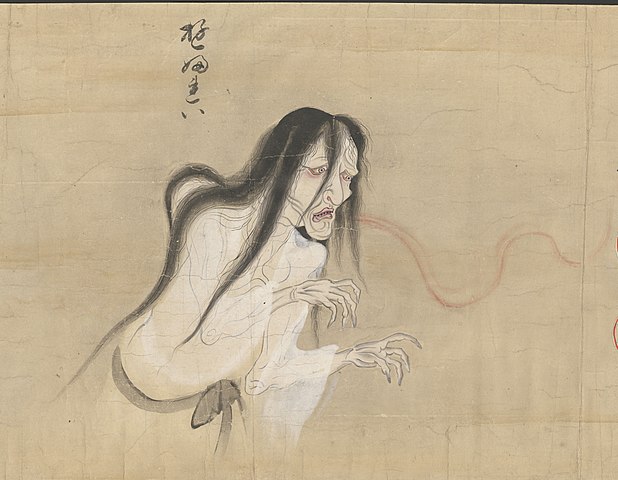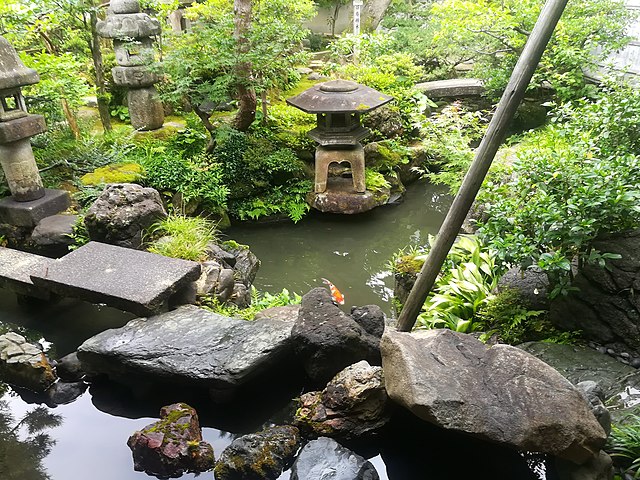Japan's fascination with mountain goblins, ghosts, and scary superstitions

Japan is super famous for its goblins, ghosts and superstitions. Believe it or not, public ghost story tellers and ghost games were all the rage on the streets of Edo Tokyo in the 1800s. And this fame continues in the Japanese horror film and manga comic book traditions with a vengance!
This essay begins with a long account about the long-nosed creature known as a tengu or mountain goblin, which inhabit forested mountains in Japan. They are mostly of a Shinto origin but some arise in certain Buddhist sects (in ancient times!). One is said to have trained the young Yoshitsune, who went on to found the Kamakura shogunate! And goblins are just the beginning.
The essay then continues with ghostly beliefs related to the end of Obon or the Festival of the Dead (after August 16 in most of Japan, marking the end of summer. Many Japanese people stop swimming after Obon out of superstition and fear. This is because the Japanese believe that the ghosts of unhappy ancestors remained caught in the water worlds. In fact, Japan is alive with stories of ghosts (and scary paintings of ghosts).
Japan has an incredible range of ghosts and ghouls where the worst of all is the yurei and they are truly frightening! Yurei are the ghosts of women who died in the grip of intense emotions such as jealousy or despair.
And then we look at all kinds of superstitions and ghostly legends about people, places and things. Kyoto, where the ghoulish film Rashomon (Kurosawa directed masterpiece), has an amazing range of weird superstions and beliefs.
Finally, this essay looks at the superstitions related to Japanese garden stones, which can only be moved if done correctly (often with a Shinto priest in attendance!). If not done right the stone's can cause mayhem for the lives of others, believe it or not! Learn more . . .
Content by Ian Martin Ropke, owner of Your Japan Private Tours (est. 1990). I have been planning, designing, and making custom Japan private tours on all five Japanese islands since the early 1990s. I work closely with Japan private tour clients and have worked for all kinds of families, companies, and individuals since 1990. Clients find me mostly via organic search, and I advertise my custom Japan private tours & travel services on www.japan-guide.com, which has the best all-Japan English content & maps in Japan! If you are going to Japan and you understand the advantages of private travel, consider my services for your next trip. And thank you for reading my content. I, Ian Martin Ropke (unique on Google Search), am also a serious nonfiction and fiction writer, a startup founder (NexussPlus.com), and a spiritual wood sculptor. Learn more!
Tengu Goblins: Mischievous mountain pranksters
The mountains throughout Japan are home to a very long-nosed creature known as a tengu or mountain goblin. The origins of tengu are not very clear. They can be found in both Shinto and Buddhist texts.
Some scholars trace the origin of the tengu to one of the primary gods of Shinto, Susano-o, who shares many of the characteristics for which tengu are feared and celebrated. Others say the idea of tengu came from China where a similar mischievous mountain spirit has long preyed on men in similar ways. Regardless of their origins, tengu are feared and regarded as real. Even as late as the mid 19th century, government officials from Edo routinely put-up official notices asking the tengu to leave a certain mountain area or to at least behave as the shogun was coming to visit.
Tengu are known to have an unusual sense of humor: they like to destroy things built in the mountains that show or are home to excessive human pride or arrogance, especially by burning them down. They are also especially fond of tormenting arrogant Buddhist priests that came to some remote mountain slope to study. They love to make fools of those who by their very arrogance or pride are clearly being foolish.
According to some, tengu have long noses because they were arrogant priests or samurai warriors in their last human life cycle. Some say that a tengu that does good deeds can be reborn as a normal human being again. The Japanese expression, “Tengu ni naru” meaning don’t be arrogant, or you will become a tengu in your next lifetime.
There are two main types of tengu goblins: the ancient karasu or raven tengu and the more human-like yamabushi (religious mountain ascetics or hermits) tengu. Karasu tengu, much like the animal they are named after, are the most mischievous of the two. They are the ones that like to kidnap children from mountainous areas, start fires and take revenge on anyone who ruins the forests that they live in. The tamer version of the karasu tengu is the yamabushi tengu. These tengu are more friendly to human and serve as wise councilors in the affairs of men. Many yamabushi were thought to possess magical powers derived from their ascetic practices and the sacredness of the mountains themselves. Over time, the folklore of tengu and yamabushi became intertwined.
Tengu, like many supernatural beings the world over, can change their form when it pleases Unlike ghosts, tengu are always shown in paintings and drawings with feet which are usually wrinkled all over to indicate that they are very old. Like ghosts, tengu can take on the form of a human being, usually old men, or women with long noses to deceive or otherwise take advantage of people. Other supernatural Japanese creatures like foxes (kitsune) and badgers (tanuki) can also change their forms but their shadow or reflection shows their true self. If a tengu is temporarily knocked out through the actions of a powerful warrior or with powerful magic it will turn into a wounded raven.

In art or literature, the tengu is often used to criticize established or new, powerful Buddhist hierarchies. Tengu hate excessive arrogance, pride and prejudice. They are therefore also depicted and respected for the role they play in protecting the Dharma (Buddhist law). Corruption among monks living in rich, protected Buddhist monasteries often resulted in those individuals become yamabushi tengu after they had died.
Tengu are often connected to the martial arts of Japan. They are said to be super skillful with a sword and equally gifted at forging the finest weapons. And throughout history, particularly strong, essentially “good”, tengu have been credited with turning merely strong fighters into super warriors.
Mount Kurama, just north of Kyoto, is a special place for tengu. It is the home of Sojobo, the so-called King of the Tengu. He is credited with training the young samurai warrior Minamoto Yoshitsune in sword fighting in the 12th century. Later Yoshitsune and his brother, Yoritomo, combined their talents and virtually wiped out the Taira clan and went on to establish the military capital of Japan in Kamakura, outside of present-day Tokyo. Today, if you go to Kurama you will see tengu masks in many of the gift shops and restaurants in the village. As this area is charged with mysterious energy, you may even feel a tengu is behind the next tree as you make your way through a thick forest alone.
August is Ghost time in Japan!
Traditionally the passing of August Obon or the Festival of the Dead (after August 16 in most of Japan) marks the end of summer. And many people stop swimming after Obon out of superstition and fear. In old Japan and even today, clearly, many people believed that the ghosts of unhappy ancestors remained caught in the water worlds. In fact, Japan is alive with superstitions and stories of ghosts.
In the late Edo period ghost stories were so popular that professional storytellers included the hyaku monogatari (One Hundred Supernatural Tales) in their repertoires. The telling of these stories was also a popular nighttime fright game in which groups of people would gather at night and light one hundred candles, taking turns telling ghost stories. For each tale told a candle was extinguished, deepening the shadows and the tension until the room was plunged into darkness—ghosts would then appear!
Among the most dangerous of the more than 500 obake (supernatural creatures) that exist in Japan are the yurei, usually the ghosts of females who died in the grip of intense emotions such as jealousy or despair, depicted as a shadowy figure draped in a white burial kimono; hands are limp and beckoning, hair long and disheveled.

A well-known yurei tale is the Yotsu-ya Ghost Story, about Oiwa and her husband, Iyemon, who betrays her. But when Iyemon tries to poison Oiwa, he only disfigures her, leaving one eye bulging from a swollen, partly bald head. Finally, he impales Oiwa and her servant to a door and throws them into a river. Thinking his troubles are over, he marries. When he lifts his bride's wedding veil he is terrified to see the vengeful face of Oiwa’s ghost. Drawing his sword, he mistakenly beheads his new bride!
Scary superstitions & mysteries in and around Kyoto
In ancient times, Kyoto was charged with all kinds of superstitious beliefs. And even today many people continue to arrange the special occasions of their life around superstitious practices. Three particularly well-documented instances of superstitious or mysterious things are the stories surrounding the astrologer Abeno Seimei; lepers and other afflicted people (known as monoyoshi); and Kiyomizu-zaka Hinin funeral purification people. Today, very few of the places associated with these mysterious people remain. However, a few mysterious things continue to live on.
Seimei Shrine Reisai (9/22,23): This temple is strongly linked with Abeno Seimei, and has many mysterious legends connected with it. Kyoto’s first imperial palace was built right in the center of the Heian capital (794). In those days, special people, called onmyo-ji, told and predicted fortunes. Many onmyo-ji worked for the emperor. The most famous onmyo-ji of all time was Abeno Seimei. He served the emperor and the Fujiwara family in the early part of the Heian period (794-1185). In addition to telling fortunes, he also held special prayers and was known as a talented astronomer. He lived near Ichijo-modori bridge (modori means to return in Japanese), a famous place that is also known as ‘the demon’s gate’ (because it was located at the northeast corner of the original imperial palace compound; the Chinese believed that danger always came from the northeast). Abeno Seimi was made to live in this place to protect the city. Today, brides and funeral cars never pass the bridge because of the legendary belief that the bridge will send them back where they came from. During WW I and II, people said goodbye to soldiers here in order to gaurantee that they would return safely. On the 22nd, from 19:00, a small parade of chochin (paper lanterns), featuring sacred music and dance, will be held. On the 23rd, from 13:00, a parade of mikoshi floats will be held. Seimei Shrine is located north of Horikawa Nakadachiuri, to get there take bus #9, get off at Ichijo-modoribashi. Tel: 441-6460.
Monoyoshi, the area around Gojo street, east of the Kamogawa River, used to be a very mysterious part of Kyoto. In the Edo period (1600-1868), many monoyoshi, people who suffered from leprosy and other kinds of disfiguring, generally horrible, diseases, lived here. On festival days and other special occasions, monoyoshi went around the city with a stick in their left hand and a mesh basket on their back, begging for food, medicine, etc. People were unusually generous with the monoyoshi for fear of divine retribution.
Kiyomizu-zaka Hinin: the eastern edge of Kyoto, especially around Kiyomizu Temple, has many large cemeteries that have been there for centuries. This area was once home to a class of people, Kiyomizu-zaka Hinin, who were beleived to have special purification powers related to funeral rituals. Many say that certain parts of the area is still charged with a special energy.
Garden stone superstitions so strong Shinto priests required!

Garden stones, believe it or not, are the most important feature of a Japanese garden. If the soil is its "flesh," then the stones are its "bones."
Garden stones fall into three basic categories: "named" stones, unimportant "unnamed" stones, and stones which already existed on the site.
The most famous named stone in Japan is called Fujito after the beach in Okayama Prefecture where it was found. It has counted among its owners Oda Nobunaga and Toyotomi Hideyoshi, two of the most important characters in Japanese history. Wrapped in silk brocade, Fujito was moved from garden to garden to the accompaniment of music. At present it is set in the garden of Sampo-in in the Daigo-ji Temple complex in southeast Kyoto.
Do-it-yourself landscape gardening is a dangerous undertaking for an inexperienced person in Japan, as there are many taboos associated with stones. Bad fortune can come from setting upright a rock that was found lying horizontally, or from setting horizontally a stone that was found standing vertically. Setting a stone upside down releases the evil spirit in the stone resulting in a whole heap of problems.
There are five colors of stone, one for each element: red for fire, black for water, blue/green for wood, white for metal, and yellow for earth. The most extreme repercussion for messing up in this category results from making the mistake of planting a tree with red blossoms next to a red stone set in the south of a garden of a person born in a year associated with fire. This is called a combination of four fires and the result will be that the unfortunate person's house will burn down.
Return to the Japanese culture essay index.
Content by Ian Martin Ropke, owner of Your Japan Private Tours (est. 1990). I have been planning, designing, and making custom Japan private tours on all five Japanese islands since the early 1990s. I work closely with Japan private tour clients and have worked for all kinds of families, companies, and individuals since 1990. Clients find me mostly via organic search, and I advertise my custom Japan private tours & travel services on www.japan-guide.com, which has the best all-Japan English content & maps in Japan! If you are going to Japan and you understand the advantages of private travel, consider my services for your next trip. And thank you for reading my content. I, Ian Martin Ropke (unique on Google Search), am also a serious nonfiction and fiction writer, a startup founder (NexussPlus.com), and a spiritual wood sculptor. Learn more!